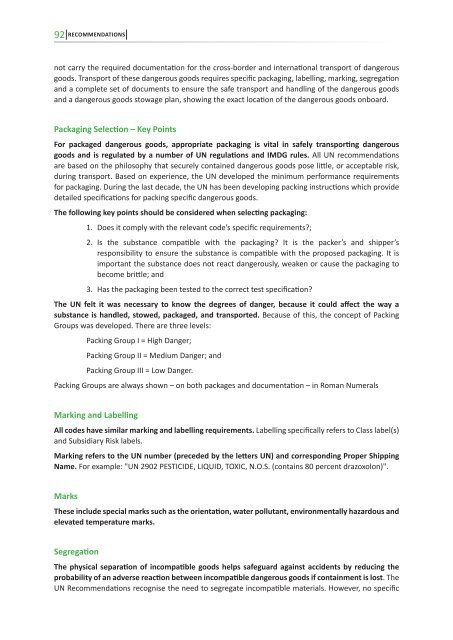Carriage, Handling and Storage of Dangerous Goods along
Carriage, Handling and Storage of Dangerous Goods along
Carriage, Handling and Storage of Dangerous Goods along
Create successful ePaper yourself
Turn your PDF publications into a flip-book with our unique Google optimized e-Paper software.
92 RECOMMENDATIONS<br />
not carry the required documentation for the cross-border <strong>and</strong> international transport <strong>of</strong> dangerous<br />
goods. Transport <strong>of</strong> these dangerous goods requires specific packaging, labelling, marking, segregation<br />
<strong>and</strong> a complete set <strong>of</strong> documents to ensure the safe transport <strong>and</strong> h<strong>and</strong>ling <strong>of</strong> the dangerous goods<br />
<strong>and</strong> a dangerous goods stowage plan, showing the exact location <strong>of</strong> the dangerous goods onboard.<br />
Packaging Selection – Key Points<br />
For packaged dangerous goods, appropriate packaging is vital in safely transporting dangerous<br />
goods <strong>and</strong> is regulated by a number <strong>of</strong> UN regulations <strong>and</strong> IMDG rules. All UN recommendations<br />
are based on the philosophy that securely contained dangerous goods pose little, or acceptable risk,<br />
during transport. Based on experience, the UN developed the minimum performance requirements<br />
for packaging. During the last decade, the UN has been developing packing instructions which provide<br />
detailed specifications for packing specific dangerous goods.<br />
The following key points should be considered when selecting packaging:<br />
1. Does it comply with the relevant code’s specific requirements?;<br />
2. Is the substance compatible with the packaging? It is the packer’s <strong>and</strong> shipper’s<br />
responsibility to ensure the substance is compatible with the proposed packaging. It is<br />
important the substance does not react dangerously, weaken or cause the packaging to<br />
become brittle; <strong>and</strong><br />
3. Has the packaging been tested to the correct test specification?<br />
The UN felt it was necessary to know the degrees <strong>of</strong> danger, because it could affect the way a<br />
substance is h<strong>and</strong>led, stowed, packaged, <strong>and</strong> transported. Because <strong>of</strong> this, the concept <strong>of</strong> Packing<br />
Groups was developed. There are three levels:<br />
Packing Group I = High Danger;<br />
Packing Group II = Medium Danger; <strong>and</strong><br />
Packing Group III = Low Danger.<br />
Packing Groups are always shown – on both packages <strong>and</strong> documentation – in Roman Numerals<br />
Marking <strong>and</strong> Labelling<br />
All codes have similar marking <strong>and</strong> labelling requirements. Labelling specifically refers to Class label(s)<br />
<strong>and</strong> Subsidiary Risk labels.<br />
Marking refers to the UN number (preceded by the letters UN) <strong>and</strong> corresponding Proper Shipping<br />
Name. For example: "UN 2902 PESTICIDE, LIQUID, TOXIC, N.O.S. (contains 80 percent drazoxolon)".<br />
Marks<br />
These include special marks such as the orientation, water pollutant, environmentally hazardous <strong>and</strong><br />
elevated temperature marks.<br />
Segregation<br />
The physical separation <strong>of</strong> incompatible goods helps safeguard against accidents by reducing the<br />
probability <strong>of</strong> an adverse reaction between incompatible dangerous goods if containment is lost. The<br />
UN Recommendations recognise the need to segregate incompatible materials. However, no specific













